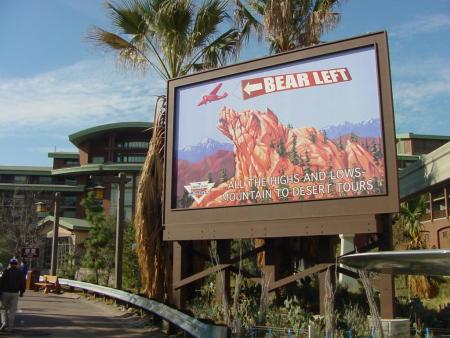Condor Flats Imagineer Interviews
Page 4 of 6

A sign points the way from Condor Flats to the Grizzly
Peak Recreational Area
Click here for a much larger version of this picture
(1024 X 768, 135,546 bytes)
LP There is a nice segue way between Condor Flats and the Grizzly area which is a separate area. I don’t really see any other areas in DCA with that smooth transition. Was that by design here?
AS: It was kind of by design because if you think of the Mojave Desert and its relationship to the Sierra Mountains, they’re actually in close proximity as you drive up to Mammoth or to Bishop up that way. You basically go from the Mojave up into the Sierra Mountains which is exactly what we have. So our transition is actually a more natural one from a geographical landscape standpoint.
LP: Was there any one thing that stands out in your mind as one of the bigger challenges of developing the Condor Flats area?
AS: It really has to do with developing that ride. We had three challenges in developing that ride. One was to create a ride system, as Mark told you about, how we were going to get guests safely up into this projection dome and be able to have them there safely. The next one was to basically create a film which we had never done before, that format, a film - and a dome if you will - we had never done a film like that. Then finally the challenge of the projection system. This is a unique projection system. Because the film is actually a forward motion through space, what tends to happen when you film like that is you get strobing if you’re filming regular motion picture speed, and we knew that going into this. Some of us had seen the motion picture projection system by IMAX where they project back instead of 24 frames a second, they project back at 48 which is twice the speed of regular motion picture film. What that in a sense does it gives the eye much more information and makes the imagery so much clearer and all of that strobing goes away. But obviously, if you’re going to make a projector work twice as hard as it is normally used to we’re going to have to do some work to get it there. We did that work.

A cappella singers dressed as aviation workmen perform
in Condor Flats
Click here for a much larger version of this picture
(940 X 763, 105,125 bytes)
LP: The vehicles themselves - how much do they move up and down and forwards and backwards during the ride?
AS: They move up and down - what we call heave. It moves up and down about 30 inches and then we actually pitch you back and forth five degrees in each direction. We played with the idea of doing what’s called roll. When a plane goes into a roll it basically banks. And we found that the heave was a better decision to go with because the camera mounted on the helicopter could do all of the roll as we do in our CircleVision films. We’re not moving, but we think we are because we grasp onto that rail. So the decision to go with the heave and the pitch was the right decision.
LP: One of the best I’ve heard from some of our readers is Soarin' Over California is the next generation CircleVision. I think that’s a great description of it. I like that it’s an attraction for the whole family. It’s not a thrill ride at all. Was that by design from the beginning?
AS: Absolutely. Absolutely. We never wanted to create a Star Tours type of ride. Star Tours is a great ride. It was innovative in its time. I still think it’s a great ride. But we really wanted more of a lyrical, romantic experience for our guests. We wanted to take their breath away. We really wanted the imagery to be the show and as I programmed the ride system I really tried to make it very transparent and invisible to the guests. I wanted it to compliment the imagery that was on the film because if the guests start thinking "wait, no, I see how I’m moving," now I’ve taken them away from the beauty that is on the screen. I just decided, and I think I was right with my colleagues, that what is on the screen is the right focal point.
LP: One of the things I also hear about is the music. Talk a little bit about that.
AS: I’m a big music fan. Honestly this was one of the high points of the attraction for me. We had the great luck to hire a gentleman by the name of Jerry Goldsmith whose extensive musical career started with Planet of the Apes. He did the Mulan score for us for feature animation. We knew that the music was going to have a big role in this. The imagery was great but the music was really going to push it over the edge. I’ll tell you honestly, and I know you’re not asking me this question, but the best moment in this entire project for me was when we took we took his film score, we cut it to the film, and we put it in the theater and the first moment - I had ridden the ride 200 times by then with just a, we had dropped in a temp track. The first time we went up and we listened to that score it brought tears to my eyes. It was that powerful. It was the proudest moment I’ve ever had on a project. It was that ten seconds. It was unbelievable.
